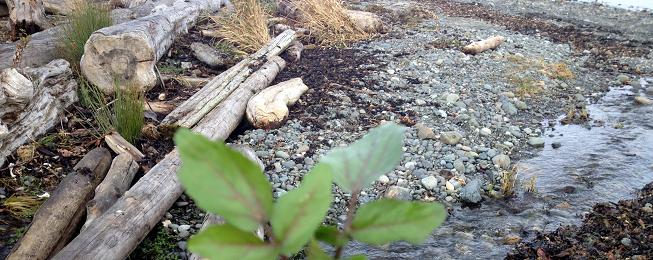 Everything is grey.
Everything is grey.
There is water out there somewhere, but no reflection from the sun. No visible horizon, just a solid, foggy expanse. Like some sort of Homeric underworld. A granite curtain, empty and undefined.
It’s bloody cold.
We are at the beach in late November, on yet another hunt for local foragables. It’s chilly enough to warrant the traditional full coat and toque combo that all Canadians (even those of us smart enough to have migrated West) have kicking about in the back of the closet. I can see my breath hissing in the ashen stillness. But, I don’t feel any chill, in fact I’m excited! Down the beach I can see it, vibrant against the grey stones… It’s green, like the Emerald city.
We’re off to see the wizard!
My companion on this trek over driftwood and across ankle-deep streams has both a working brain and ticking heart. It’s Toni… of course, it’s Toni. Long time readers will already be familiar with my close friend and guru from the countless posts that involve us criss-crossing the neighbourhood in search of wild edibles. She’s the best, and one of the few people I’ll answer the phone for on my day off.
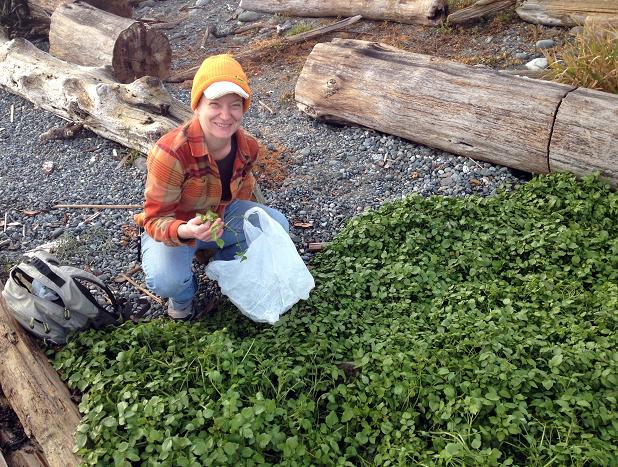 She messaged me earlier that week saying she’d found a spot with some very special weeds. A certain peppery, water-dwelling plant that thrived even during these grim winter months. Watercress! A plant that I’d bought from whole food stores, and spied loitering in ditches, but had never actually harvested for myself.
She messaged me earlier that week saying she’d found a spot with some very special weeds. A certain peppery, water-dwelling plant that thrived even during these grim winter months. Watercress! A plant that I’d bought from whole food stores, and spied loitering in ditches, but had never actually harvested for myself.
Bright and early she arrived, windows down, stereo blasting the alt-punk styling’s of The Stranglers. I hustled out, my kit in tow:
What you will need to forage Watercress
- Boots – Watercress grows in water (it’s in the name) so you should be prepared for some serious squelching. Bring your big boots or spend the ride home with cold, wet toes.
- Winter Coat and Toque – It’s winter man.
- Plastic Bag – You’ll want one big enough to carry your pickings home with enough extra space so that they aren’t all crushed together. Bags from Big-box stores work really well.
Toni is always a fascinating person to talk to, and literally vibrates with excitement when she’s got a new thing she wants to share: “Oh my Gad! These guys have been around for decades! It’s like finding a buried treasure band” or “It turns out you can actually eat it if you cook the bejezzus out of it” or my favourite, “Seriously, with just this book you can learn how to speak Hebrew in a week!”
We arrived in Merville a little while later (a township just down the road from us), having switched from punk to full on Mongolian throat-singing-death metal. We were both pretty jazzed from all the coffee, loud music and shouting news at each other… So when we stepped out onto the beach, the silence soaked us like a Superbowl Gatorade shower.
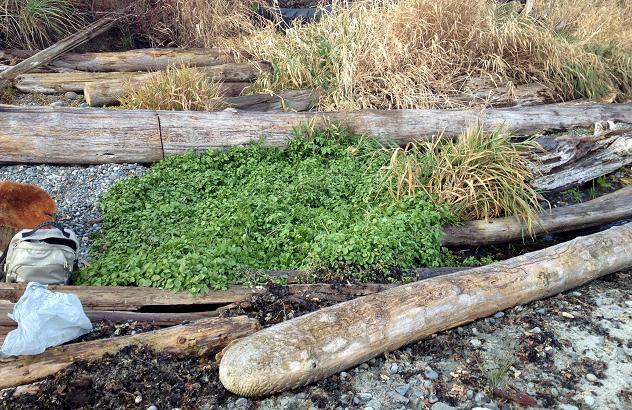 The watercress patch (our “Emerald City”) was just a short walk from the parking lot, growing amongst driftwood in the sandy soil beside a stream. It was roughly 6×6 feet and very hard to miss due to it’s brilliant colour.
The watercress patch (our “Emerald City”) was just a short walk from the parking lot, growing amongst driftwood in the sandy soil beside a stream. It was roughly 6×6 feet and very hard to miss due to it’s brilliant colour.
Watercress is a semi-aquatic plant – Which means that it can grow either directly in, or next to a running water source. The stems of the plant are green-turning to reddish brown near the leaves, hollow and float in water. The leaf perched on the tip of each stalk is large and spoon-shaped, with clearly visible whitish or red veins. A series of two smaller, almond-shaped leaves run down the stalk in descending size every inch or so. All told, each stem has about five leaves. During the summer months the ‘cress busts out clusters of pretty little white flowers, which make it even easier to identify.
The plant uses it’s own floating bulk as a structure on which to grow new stems, intertwining them with the older, thicker stuff without much of a plan. The whole patch, when viewed from above resembles a big green, poorly-knitted scarf or a plate of spaghetti.
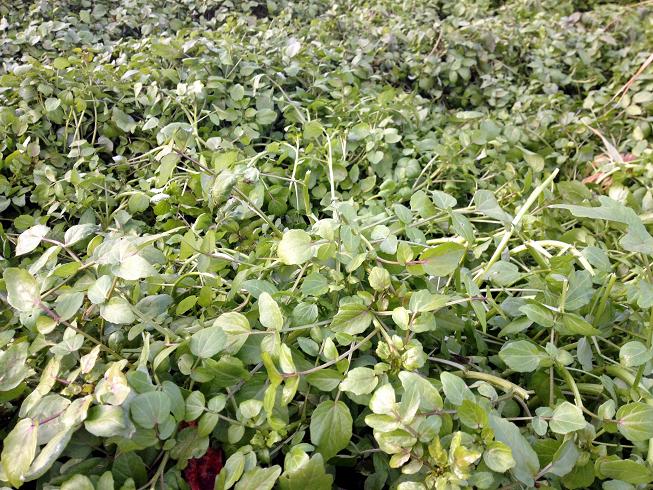 When I popped some into my mouth Toni laughed and said, “I’m sure glad you ate some first, ‘cause there is a chance this is Hemlock! I’ll wait to see what colour you turn.”
When I popped some into my mouth Toni laughed and said, “I’m sure glad you ate some first, ‘cause there is a chance this is Hemlock! I’ll wait to see what colour you turn.”
Yeah, there are a handful of other semi-aquatic plants that resemble watercress that can be very dangerous to humans, most notably Water Hemlock. Star Trek fans will recognize that plant as the one Quinn uses to commit suicide in a Voyager episode… Death in minutes. No cure. Needless to say, make sure you correctly identify your edibles with a manual or go foraging with someone who knows what’s what… Jokers like Toni.
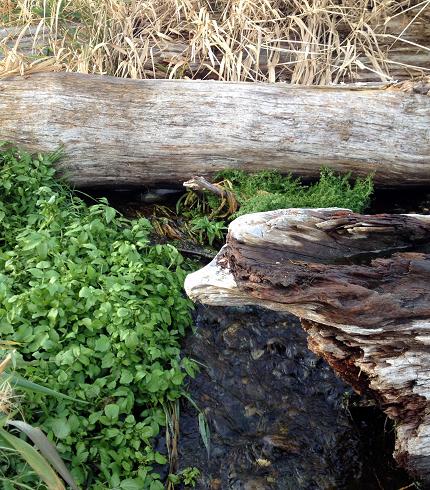 Also, it’s important to check the quality of the water your ‘cress is growing in. Dirty or contaminated water from nearby farms/factories (especially ones with cattle or that use pesticides) can fill your greens with parasites that may potentially harm you and your dinner guests. Scout out the stream before you get picking, and avoid ditches.
Also, it’s important to check the quality of the water your ‘cress is growing in. Dirty or contaminated water from nearby farms/factories (especially ones with cattle or that use pesticides) can fill your greens with parasites that may potentially harm you and your dinner guests. Scout out the stream before you get picking, and avoid ditches.
Like most wild herbs, watercress is most delicate and delicious up at the tip, where the leaves live as opposed to down in the muck where the thick, woody stems hang out. Toni and I just used out hands to twist off the top five leaves-worth of stem and left the rest to re-grow for our next adventure. It only took ten minutes to fill two big bags worth of weeds! We spent the rest of our time sitting around, staring out into the grey and talking about life after my imminent Hemlock-related death.
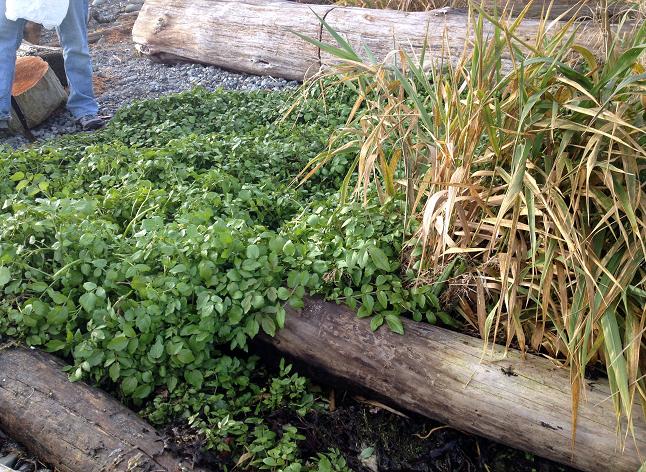 “Isn’t it amazing?” Toni said, switching gears and gesturing at the ‘cress, “It’s winter man, there is snow in some places and here’s all this green. Imagine starving for food and finding it. What a miracle!”
“Isn’t it amazing?” Toni said, switching gears and gesturing at the ‘cress, “It’s winter man, there is snow in some places and here’s all this green. Imagine starving for food and finding it. What a miracle!”
I agreed. It’s one of the only green, edible plants alive at this time of year, and contains enough vitamins and nutrients to keep any starving forager alive and well. It’s especially notable for it’s cleansing effect on the stomach and liver and has been hailed (as any wild-growing green plants is lately) as a superfood-du-jour for health nuts and dieters.
The texture of ‘cress is crisp on the outside and moist on the inside, much like bok choi and other members of the Chinese cabbage family (to which watercress is distantly related).
The flavour is unmistakably mustard-like with undertones of pepper, cucumber and cilantro’s “rusty penny-ness”. It’s a great pair with fried fish, spuds, eggs and tends to find it’s way onto a lot of brunch menus as a result. It’s also a great addition to salads with slightly less assertive greens and creamy dressings… Mmmmmmm.
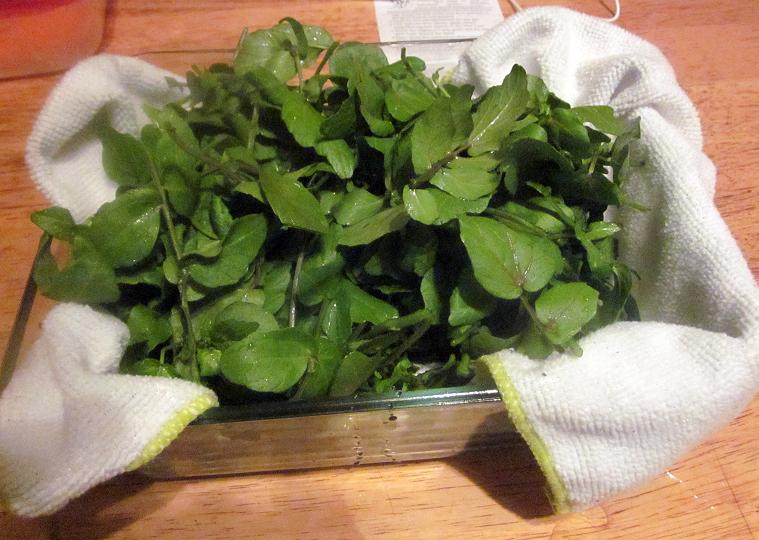 Later, when I got home I placed the ‘cress in a large glass container with a moistened towel lining the inside and it stayed good for more than a week. So don’t let all the stuff you read online about a two day shelf life spook you, if the ‘cress is fresh enough, and the weather’s cold enough, it will last.
Later, when I got home I placed the ‘cress in a large glass container with a moistened towel lining the inside and it stayed good for more than a week. So don’t let all the stuff you read online about a two day shelf life spook you, if the ‘cress is fresh enough, and the weather’s cold enough, it will last.
Toni and I packed up our loot and tromped back across the stony shoreline to the car. It wasn’t even lunchtime yet, we were still a bit giddy and ‘lookin for more food-related fun.
“I think we passed a farm on our way here. You ‘wanna check it out?” Toni gunned the engine and smiled her mega-watt mad grin at me, “I’m game.”
Hit up Walking on the Beaches, Part 2 to continue the adventure! And find out how I cooked up my watercress Here!